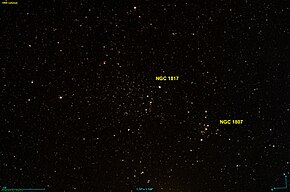
Summary
NGC 1817 is an open cluster of stars in the constellation Taurus. It was discovered by English astronomer William Herschel in February 1784.[5] With an apparent magnitude of 7.7[3] and spanning 9.3 arc minutes across the sky, it is separated from the NGC 1807 cluster by just 26 arc minutes.[6][circular reference] Indeed, the two may actually be parts of a single extended cluster.[5]
| NGC 1817 | |
|---|---|
 NGC 1817 as seen by the DSS | |
| Observation data (J2000 epoch) | |
| Right ascension | 05h 12m 15.(0)s[1] |
| Declination | +16° 41′ 2(4)″[1] |
| Distance | 6,430 ly (1,972 pc)[2] |
| Apparent magnitude (V) | 7.7[3] |
| Apparent dimensions (V) | 9.3′[3] |
| Physical characteristics | |
| Estimated age | 0.8−1.2[4] Gyr |
| Other designations | C 0509+166, Collinder 60 |
| Associations | |
| Constellation | Taurus |
The NGC 1817 cluster is around the same age as the Hyades, or perhaps a little younger at 0.8−1.2 billion years. The turnoff point for this cluster—where stars above a certain mass are evolving through the red giant stage—is twice the mass of the Sun.[7] The cluster is situated in the opposite side of the sky from the Galactic Center at a separation of 32 kly (9.9 kpc) from the core,[7] and is around 1.3 kly (0.4 kpc) away from the Galactic plane.[4]
Measurements of the proper motion of 810 stars within a 1.5° region centered on the cluster suggest that it has at least 169 members.[8] Of these, there is a total of 26 variable stars, including three candidate Gamma Doradus variable stars and sixteen Delta Scuti variables.[9] This unusually high proportion of Delta Scuti variables is likely the result of the turnoff point being located within the instability strip.[5]
Gallery edit
-
Open clusters NGC 1807 and 1817 showing separation of 26'
References edit
- ^ a b Wu, Zhen-Yu; et al. (November 2009), "The orbits of open clusters in the Galaxy", Monthly Notices of the Royal Astronomical Society, 399 (4): 2146–2164, arXiv:0909.3737, Bibcode:2009MNRAS.399.2146W, doi:10.1111/j.1365-2966.2009.15416.x, S2CID 6066790.
- ^ Kharchenko, N. V.; et al. (August 2005). "Astrophysical parameters of Galactic open clusters". Astronomy and Astrophysics. 438 (3): 1163–1173. arXiv:astro-ph/0501674. Bibcode:2005A&A...438.1163K. doi:10.1051/0004-6361:20042523. S2CID 9079873.
- ^ a b c "The Sky Live - NGC 1817 - Open Cluster in Taurus". The Sky Live. Retrieved 11 December 2021.
- ^ a b Donati, P.; et al. (January 2014), "NGC 1817, NGC 2141 and Berkeley 81: three BOCCE clusters of intermediate age", Monthly Notices of the Royal Astronomical Society, 437 (2): 1241–1258, arXiv:1311.2469, Bibcode:2014MNRAS.437.1241D, doi:10.1093/mnras/stt1944.
- ^ a b c O'Meara, Stephen James (2011), Deep-Sky Companions: The Secret Deep, vol. 4, Cambridge University Press, p. 84, ISBN 978-1139500074.
- ^ "NGC 1807 and 1817 separation". Retrieved 11 December 2021.
- ^ a b Reddy, Arumalla B. S.; et al. (January 2012), "Comprehensive abundance analysis of red giants in the open clusters NGC 752, 1817, 2360 and 2506", Monthly Notices of the Royal Astronomical Society, 419 (2): 1350–1361, arXiv:1109.2678, Bibcode:2012MNRAS.419.1350R, doi:10.1111/j.1365-2966.2011.19791.x, S2CID 117721721.
- ^ Balaguer-Núñez, L.; Jordi, C.; Galadí-Enríquez, D.; Zhao, J. L. (November 2004), "New membership determination and proper motions of NGC 1817. Parametric and non-parametric approach", Astronomy and Astrophysics, 426 (3): 819–826, arXiv:astro-ph/0407455, Bibcode:2004A&A...426..819B, doi:10.1051/0004-6361:20041332, S2CID 14843703.
- ^ Andersen, M. F.; et al. (July 2009), "NGC 1817: the richest population of delta Scuti stars", Communications in Asteroseismology, 160: 9, Bibcode:2009CoAst.160....9A, doi:10.1553/cia160s9.
External links edit
- Media related to NGC 1817 at Wikimedia Commons


